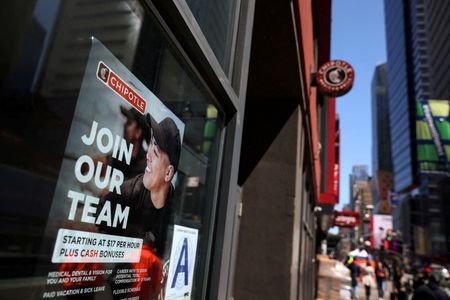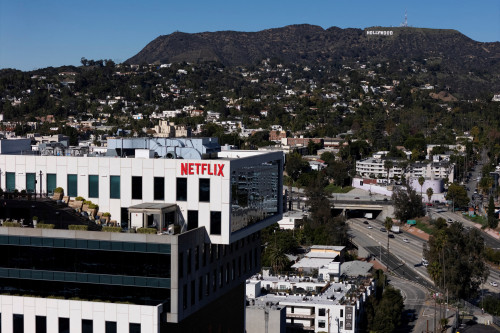By Lucia Mutikani
WASHINGTON (Reuters) – The number of Americans filing new claims for unemployment benefits fell last week, pointing to continued tightness in the labor market even as job growth slows.
Labor market tightness is underpinning the economy, with data this week showing a solid increase in retail sales in July and a surge in single-family homebuilding, which prompted economists to raise their growth estimates for the third quarter. But that resilience raises the risk that the Federal Reserve could hike interest rates again.
“The labor markets are not imploding,” said Christopher Rupkey, chief economist at FWDBONDS in New York. “The economy may be heating up instead of cooling down as the monetary medicine of higher 5.5% interest rates is not slowing aggregate demand like the economics textbooks say it should.”
Initial claims for state unemployment benefits dropped 11,000 to a seasonally adjusted 239,000 for the week ended Aug. 12, reversing half of the surge in the prior week, the Labor Department said on Thursday. Economists polled by Reuters had forecast 240,000 claims for the latest week.
Claims shot up in the week ending Aug. 5, with applications in Ohio accounting for a big chunk of the increase.
The state, which has previously experienced fraudulent filings, attributed the jump to layoffs in the manufacturing and automobile industries. Automakers normally idle plants in July to retool for new models.
Unadjusted claims dropped 15,067 to 212,850 last week. Claims in California declined by 3,519. There were also notable decreases in Texas, Michigan, New Jersey and Pennsylvania, which more than offset a sizeable increase in Virginia.
The labor market is only slowing at the margin, with job gains in July being the second-smallest since December 2020. The unemployment rate is hovering around levels last seen more than 50 years ago. There were 1.6 job openings for every unemployed person in June.
Claims, relative to the size of the labor market, are way below the 280,000 level that economists say would signal a significant slowdown in job growth.
The minutes of the Fed’s July 25-26 meeting, where were published on Wednesday, showed that while policymakers acknowledged “signs that demand and supply were coming into better balance,” they “judged that further progress toward a balancing of demand and supply in the labor market was needed, and they expected that additional softening in labor market conditions would take place over time.”
Stocks on Wall Street were trading lower. The dollar fell against a basket of currencies. U.S. Treasury yields were mostly higher.
RECESSION FORECASTS DIALED BACK
The U.S. central bank since March 2022 has raised its benchmark overnight interest rate by 525 basis points to the current 5.25%-5.50% range.
Most economists believe the rate hiking cycle is likely over, given the recent moderation in inflation, though an increase cannot be ruled out at its Oct. 31-Nov. 1 policy meeting. Fed Chair Jerome Powell’s speech at the Jackson Hole economic symposium next week could shed more light on the outlook for monetary policy.
Economists have dialed back their forecasts for a recession this year, and are increasingly warming up to the idea that the Fed could guide the economy to a “soft landing.”
Still, a gauge of future economic activity dropped for the 16th straight month in July, the Conference Board reported on Thursday. Labor market strength, excess savings accumulated during the COVID-19 pandemic and greater credit card usage to fund purchases have kept a recession at bay.
“Investors must come to grips with the uniqueness of this economic cycle,” said Jeffrey Roach, chief economist at LPL Financial in Charlotte, North Carolina. “This time is different. Normally, the economy would be in recession when the Conference Board data look this frail.”
The claims data covered the period during which the government surveyed business establishments for the nonfarm payrolls component of August’s employment report. Claims rose slightly between the July and August survey period.
Data next week on the number of people receiving benefits after an initial week of aid, a proxy for hiring, will offer more clues on the health of the labor market in August.
The so-called continuing claims increased 32,000 to 1.716 million during the week ending Aug. 5, the claims report showed.
Continuing claims remain low by historical standards, indicating that some laid-off workers are experiencing short bouts of unemployment. Some economists saw the slight elevation as indicating a small margin of slack in the job market.
“The labor market is still strong but much more balanced than during the severe worker shortages of the early recovery from the pandemic,” said Bill Adams, chief economist at Comerica Bank in Dallas.
A third report from the Philadelphia Fed showed factory activity in the mid-Atlantic region rebounded in August for the first time in a year, but firms in the region that covers eastern Pennsylvania, southern New Jersey and Delaware reported a decline in employment. They also were less upbeat about business conditions in the next six months.
The Philadelphia Fed’s business conditions index increased to a reading of 12.0 this month from -13.5 in July. The jump, however, likely overstates the health of manufacturing, which continues to be hamstrung by higher borrowing costs.
A survey this week from the New York Fed showed business conditions in the “Empire State” remained depressed in August.
The Philadelphia Fed survey’s measure of employment dropped to -6.0 from -1.0 in July. But the average workweek rebounded, indicating factories were increasing hours for their current workforces. The survey’s six-month business conditions index dropped to 3.9 from 29.1 in July.
“It is hard to know what to make of these contrasting signals, but the ‘truth’ to underlying conditions in the sector is probably somewhere between the two extremes,” said Daniel Silver, an economist at JPMorgan in New York.
(Reporting by Lucia Mutikani; Editing by Chizu Nomiyama and Paul Simao)





